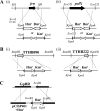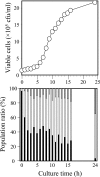An extreme thermophile, Thermus thermophilus, is a polyploid bacterium
- PMID: 20729360
- PMCID: PMC2950507
- DOI: 10.1128/JB.00662-10
An extreme thermophile, Thermus thermophilus, is a polyploid bacterium
Abstract
An extremely thermophilic bacterium, Thermus thermophilus HB8, is one of the model organisms for systems biology. Its genome consists of a chromosome (1.85 Mb), a megaplasmid (0.26 Mb) designated pTT27, and a plasmid (9.3 kb) designated pTT8, and the complete sequence is available. We show here that T. thermophilus is a polyploid organism, harboring multiple genomic copies in a cell. In the case of the HB8 strain, the copy number of the chromosome was estimated to be four or five, and the copy number of the pTT27 megaplasmid seemed to be equal to that of the chromosome. It has never been discussed whether T. thermophilus is haploid or polyploid. However, the finding that it is polyploid is not surprising, as Deinococcus radiodurans, an extremely radioresistant bacterium closely related to Thermus, is well known to be a polyploid organism. As is the case for D. radiodurans in the radiation environment, the polyploidy of T. thermophilus might allow for genomic DNA protection, maintenance, and repair at elevated growth temperatures. Polyploidy often complicates the recognition of an essential gene in T. thermophilus as a model organism for systems biology.
Figures







Similar articles
-
The genome sequence of the extreme thermophile Thermus thermophilus.Nat Biotechnol. 2004 May;22(5):547-53. doi: 10.1038/nbt956. Epub 2004 Apr 4. Nat Biotechnol. 2004. PMID: 15064768
-
Mapping of 61 genes on the refined physical map of the chromosome of Thermus thermophilus HB27 and comparison of genome organization with that of T. thermophilus HB8.Microbiology (Reading). 1996 Feb;142 ( Pt 2):401-410. doi: 10.1099/13500872-142-2-401. Microbiology (Reading). 1996. PMID: 8932713
-
Characterization of chromosomal and megaplasmid partitioning loci in Thermus thermophilus HB27.BMC Genomics. 2015 Apr 18;16(1):317. doi: 10.1186/s12864-015-1523-3. BMC Genomics. 2015. PMID: 25909452 Free PMC article.
-
Nitrate Respiration in Thermus thermophilus NAR1: from Horizontal Gene Transfer to Internal Evolution.Genes (Basel). 2020 Nov 4;11(11):1308. doi: 10.3390/genes11111308. Genes (Basel). 2020. PMID: 33158244 Free PMC article. Review.
-
Bioenergetics at extreme temperature: Thermus thermophilus ba(3)- and caa(3)-type cytochrome c oxidases.Biochim Biophys Acta. 2012 Apr;1817(4):638-49. doi: 10.1016/j.bbabio.2011.08.004. Biochim Biophys Acta. 2012. PMID: 22385645 Review.
Cited by
-
A thermostable DNA primase-polymerase from a mobile genetic element involved in defence against environmental DNA.Environ Microbiol. 2020 Nov;22(11):4647-4657. doi: 10.1111/1462-2920.15207. Epub 2020 Sep 3. Environ Microbiol. 2020. PMID: 32830367 Free PMC article.
-
Roles of Mn-catalase and a possible heme peroxidase homologue in protection from oxidative stress in Thermus thermophilus.Extremophiles. 2015 Jul;19(4):775-85. doi: 10.1007/s00792-015-0753-2. Epub 2015 May 22. Extremophiles. 2015. PMID: 25997395
-
Extreme Polyploidy of Carsonella, an Organelle-Like Bacterium with a Drastically Reduced Genome.Microbiol Spectr. 2022 Jun 29;10(3):e0035022. doi: 10.1128/spectrum.00350-22. Epub 2022 Apr 18. Microbiol Spectr. 2022. PMID: 35435757 Free PMC article.
-
Role of Archaeal HerA Protein in the Biology of the Bacterium Thermus thermophilus.Genes (Basel). 2017 Apr 27;8(5):130. doi: 10.3390/genes8050130. Genes (Basel). 2017. PMID: 28448436 Free PMC article.
-
Maintenance of multipartite genome system and its functional significance in bacteria.J Genet. 2018 Sep;97(4):1013-1038. J Genet. 2018. PMID: 30262715 Review.
References
-
- Angert, E. R., and K. D. Clements. 2004. Initiation of intracellular offspring in Epulopiscium. Mol. Microbiol. 51:827-835. - PubMed
-
- Bremer, H., and P. P. Dennis. 1996. Modulation of chemical composition and other parameters of the cell growth rate, p. 1553-1566. In F. C. Neidhardt (ed.), Escherichia coli and Salmonella. ASM Press, Washington, DC.
-
- Brouns, S. J., H. Wu, J. Akerboom, A. P. Turnbull, W. M. de Vos, and J. van der Oost. 2005. Engineering a selectable marker for hyperthermophiles. J. Biol. Chem. 280:11422-11431. - PubMed
Publication types
MeSH terms
LinkOut - more resources
Full Text Sources
Research Materials
Miscellaneous

